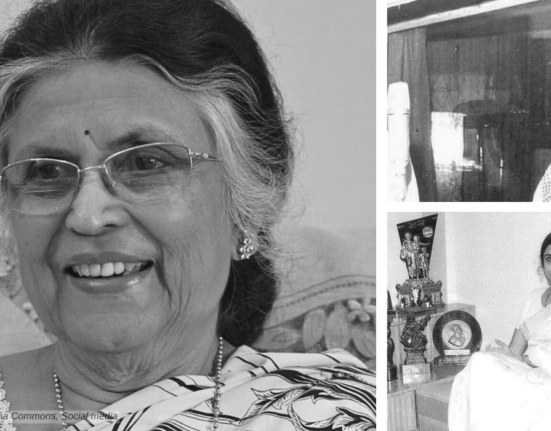The tale of Naushad’s foray into Indian cinema is as captivating as his melodies. Naushad came into the world on December 25, 1919, in Lucknow and spent his formative years in this culturally rich city. His father, Wahid Ali, served as a court clerk (Munshi). Naushad’s early exposure to music included annual visits to the Deva Sharif fair in Barabanki, where renowned qawwals and musicians showcased their talents.
His musical education flourished under the guidance of maestros like Ustad Ghurbat Ali, Ustad Yusuf Ali, and Ustad Babban Saheb at this vibrant cultural hub, where he also honed his skills in repairing harmoniums. All this without the approval of his father. As a little boy, Naushad showed tremendous growth and calibre and became a vital part of a junior theatrical club, where he assumed the role of the club’s music maestro for their stage productions.
when an unknown printer took a galley of type and scrambled it to make a type area specimen book It has survived not only five centuries.but also the leap introduce electronic typesetting, remaining essentially unchanged.
Willum Skeener
Naushad was born into a conservative household that disapproved of music and films. He faced a dilemma when his father discovered a clandestine harmonium in their home. He shattered the instrument and issued an ultimatum: music or family. Choosing his passion, Naushad ran away in late 1937 and embarked on a journey to Bombay to try his luck as a musician.
Middle Post Heading
In Bombay, the 18-year-old Naushad found himself alone, without friends or relatives for support. Ustad Jhande Khan became a guiding figure, offering him a role to play the piano for a monthly salary of Rs 40. Subsequently, he gained experience as an assistant under music directors Mushtaq Hussain and Khemchand Prakash.
In 1940, the lyricist and screenplay writer DN Madhok endorsed Naushad as an independent music director for Bhavnani Productions’ Prem Nagar. Naushad continued his musical journey, creating compositions for 11 more films, steadily solidifying his standing in the film industry. However, it was the 1944 movie “Rattan” that propelled him to immediate superstardom. The film’s soundtrack became a sensation, propelling it to become the highest-grossing movie of the year.

With this success, Naushad’s name resonated in households across undivided India. Songs like Akhiya Milake Jiya Bharmake in Zohrabai Ambalawali’s voice are remembered even today.
This was followed by a string of hit scores for movies like Shahjehan (1946), Anmol Ghadi (1946), Dard (1947), Mela (1948), and Andaz (1949), among others. The pathos-laden “Awaz de Kahan hai “from Mahboob Khan’s Anmol Ghadi in Noor Jahan’s evocative voice is remembered to this day, and, through decades, the diva’s concerts would invariably feature the gem. In Dard (1947), Naushad Sahab’s tunes found their soulmate in Shakeel Budayuni’s words.
Next comes Dilip Kumar and Nargis starrer Mela (1948), which has songs like “Ye Zindagi Ke Mele,” “Gaye Ja Geet Milan Ke Tu Apni Lagan Ke,” and “Shaayad Wo Ja Rahe Hain, Chhup Kar Miri Nazar Se.” A. R. Kardar’s “Dulari (1948),” starring Madhubala, Suresh, and Geeta Bali, has one of the finest Rafi numbers, “Suhani Raat Dhal Chuki.”
When Naushad handed Lata Mangeshkar the song “Uthaye Ja Unke Sitam” in “Andaz,” there were doubts about whether a Maharashtrian girl could do justice to an Urdu ghazal. Despite reservations, including from Mehboob Khan, Naushad took on the challenge. He dedicated days to rigorously training Lata Ji, refining her diction and pronunciation, and familiarising her with the composition’s notes. When Lata was prepared, she delivered the rendition flawlessly in a single take, putting any doubts to rest.
Success is how high you bounce when you hit bottom
In 1950 comes “Babul,” which has songs like “Chhod Babul Ka Ghar” and “Milte Hi Ankhen Dil Hua Diwana Kisi Ka.” Apart from Dilip Kumar’s superlative performance, “Deedar (1951)” had songs like “Hue Hum Jinke Liye Barbaad,” “Chaman Mein Rakhe Veerana,” and “Meri Kahani Bhoolne Wale,” which made “Deedar” a mega-hit.
In “Aan (1952),” which has songs like “Dil Mein Chhupake Pyar Ka Toofan Le Chale” and “Maan Mera Ehsan, Arrey Nadaan,” Naushad experimented with a hundred-piece orchestra—a first in Indian film music. It was also the first time that Indian film music was written in Western notation, which was published in the form of a book in London.
Then comes “Baiju Bawra (1952),” which demonstrated Naushad’s grasp of classical music and his ability to bring it to the masses. The compositions of Baiju Bawra were inspired by ragas, and he even used distinguished classical artists like Amir Khan and D.V. Paluskar in Baiju Bawra. He won the first Filmfare Best Music Director Award in 1954 for Baiju Bawra. The film has gems like “Man Tarapat Hari Darshan Ko Aaj,” “O Duniya Ke Rakhwale,” “Door Koi Gaye,” “Tu Ganga Ki Mauj Mein Jamana Ka Dhara,” and “Door Koi Gaye Dhun Yeh Sunaaye.”
By the early 1950s, Naushad had stamped his authority as the numero uno in the industry. He was the highest-paid composer and was selective about which films to accept. The mere mention of Naushad in the titles guaranteed a film’s success. So popular were Naushad’s compositions that when he married, the band that accompanied him to his bride’s house played all his tunes, unaware that he was their creator.
1954 brings Mehboob Khan’s “Amar,” which came in 1954 and starred Dilip Kumar, Madhubala, and Nimmi. Amar’s songs like “Tere Sadake Balam Na Kar Koi Gam,” “Na Milta Gham Tau Barbadi Ke Afsaane Kahan Jaate,” and “Umangon Ko Sakhi Pi Ki Nagariyaa Kaise Le Jaaun” are still hummed with love.
Mehboob Khan’s next was his magnum opus “Mother India,” where Naushad Saab gave us songs like “Duniya Mein Hum Aaye Hain,” “Dukh Bhare Din Beete Re,” “O Gaadiwale,” “Nagari Nagari Dware Dware,” and one of the finest holi songs, “Holi Aayi Re Kanhai,” among others.
In his early days, Naushad worked with several singers, but once he felt that Lata Mangeshkar and Rafi were ready to deliver, he gave almost all of his solos and duets to them. Other composers who always looked up to him—some of them enviously—followed suit. This established the duo as the king and queen of playback singing.
The 1960s began with the superhit comedy Kohinoor, starring Dilip Kumar and Meena Kumari as lead actors. The classical composition of “Madhuban Mein Radhika Nache Re” and other numbers such as “Do Sitaron Ka Zameen Par Hai Milan Aaj Ki Raat” continue to mesmerise music lovers today.
Kohinoor was followed by K. Asif’s magnum opus Mughal-e-Azam (1961), where in the song “Ae Mohabbat Zindabad,” he used a chorus of 100 people. He also managed to convince Ustad Bade Ghulam Ali Khan Saab to sing as the voice of Tansen in “Prem Jogan Ban Ja” and “Shubh Din Aayo.”.
“Insaaf Ki Dagar Pe,” one of the most popular patriotic songs in Hindi cinema, comes in “Gunga Jamuna (1961). Some other songs from the film are “Do Hanson Ka Joda,” “Nain Lad Jaihe To,” and “Dhundo Dhundo Re Sajna.”


Some of his other famous songs are “Tumhare Sang Main Bhi Chaloongi” (Soni Mahiwal), “Yaad Mein Teri,” “Mere Mehboob Tujhe,” “E-HHusn Jara Jaag (Mere Mehboob), “Apni Azadi ko ha,” “Mujhe Duniya walo(leader), “Koi Sagar Dil Ko Behlata Nahin” “Guzre Hain Aaj Ishq Mein (Dil Diya Dard Liya), “Jogan Ban Jaungi Sayyan Tore Karan,” “Chandan Ka Palna Resham Ki Dor,” “Aaye Na Balam Wada Karke” (Shabab), “More Saiyan Ji Utrenge Paar” (Uran Khatola), “Nanha Munna Rahi Hoon” (Son of India), “Aaj Ki Raat Mere Dil Ki” “Balam Tere Pyar Ki Thandi Aag Mein Jalte Jalte Main,” “Dheere Dheere Bol, Koi Sun Lega Sajna” (Ram aur Shyam),” “Jaanewale Tera Khuda Hafiz(Palki),” “Na Aadmi Ka Koi Bharosa,” “Aaj Puraani Raahon Se (Aadmi),” “Jab Dil Se Dil Takrata Hai” “Ishq Deewana, Husn Bhi Ghayal” “Mere Pairon Mein Ghunghroo” (Sunghursh), “Mera Pyar Bhi Tu Hai” (Saathi), and many more.
Apart from using classical ragas and folk music, especially Awadhi folk, Naushad’s music was also influenced by the age-old tradition of Nauha Gari and Marsiya Khwani (the songs traditionally sung to remember the martyrdom of Imam Hussain). As Lucknow was the epicentre of the Muharram, the art of Nauha and Marsiya greatly developed there, which had their basis in classical music but without instruments.
When the music director of Pakeezah (1972), Ghulam Muhammad, passed away, it was Naushad who completed the track besides scoring the entire background music, which includes classical compositions like “Najariya ki mari” by Rajkumari, “Mora Saajna” by Vani Jairam, and “Kaun Gali Gayo Shyam” by Begum Parveen sultana.
The Pakeezah title music, known as Tarana-e-Pakeezah, is a seminal piece of work, with Lata’s amazing vocals creating an ethereal effect with the alaap that interludes the music.
Naushad composed for a few films during the seventies, eighties, and nineties, but he was, by and large, disheartened by what he saw as a decline in the glorious traditions of Hindi film music.
With a deep appreciation for Ganga-Jamuni syncretic values, Naushad, who passed away on May 5, 2006, proudly referred to “Man Tarpat Hari Darshan Ko,” a bhajan from “Baiju Bawra,” as “written by a Muslim, composed by a Muslim, and sung by a Muslim.”
Naushad Saab received numerous esteemed honours including the Padma Bhushan and the Dadasaheb Phalke Award for his remarkable contributions to Indian cinema. Additionally, he was recognized with accolades like the Lata Mangeshkar Award, Amir Khusro Award, Sangeet Natak Akademi Award.
Naushad Saab passed away on 5 May 2006 in Mumbai due to cardiac arrest at age 86 and was buried at the Juhu Muslim cemetery.
Naushad Saab revolutionised popular film music by infusing classical music ragas and folk melodies into his tunes while simultaneously introducing Western notations. His exceptional command of his craft earned him the title Mauseeqar-e-Azam—The Grand Musician.












